With the demise of AlphaDream in 2019, fans wondered if that was it for the Mario & Luigi series. After all, it was never the highest selling series in the world, nor the one that got the most attention or marketing from Nintendo.
As a result, there was a worry the company would call it a day on the franchise. Consider the failure of the remakes a sign the series had lost its shine, and move onto newer and potentially greener pastures.
Fortunately, that’s not the case! Instead, Nintendo and Acquire made a brand-new Mario & Luigi game, in the form of Mario & Luigi: Brothership. With an intriguing story and cast of characters, a beautiful new visual style and some very familiar gameplay, it had all the ingredients to be the revival fans dreamed of. The comeback Mario & Luigi always deserved, but which we worried they’d never get.

But is Brothership that comeback? Is the latest Mario & Luigi game really as good as those that came before it?
Well for the most part, yes. Mario & Luigi: Brothership is a cracking return to form that should please fans of the series to no end.
With the aforementioned visuals being a huge part of that. You see, when we heard the game was going fully 3D, we had our doubts here. Would the characters really be as expressive as in the earlier games? Could character designs be as interesting when they’ve got to be modelled to look good from multiple angles? Is it even possible to replicate the style of a series like Mario & Luigi in 3D at all?
As it turns out, the answer to all of those questions is a resounding yes. Mario & Luigi: Brothership looks beautiful, and keeps all the charm of the earlier games intact.
And the expressiveness of the characters plays a huge part in that. Cause while the later 3DS games toned down the facial expressions and animations…
Brothership goes completely the other way. Now everyone is livelier and more expressive than ever, with some of the most hilarious cutscenes and reactions resulting from it. It’s really great to see, and makes for a game with almost Saturday morning cartoon level vibes.

It’s especially noticeable in cutscenes like the intro, where everyone has the most exaggerated expressions possible
Of course, the expressions are only a part of the game. If the characters looked uninteresting, or the worlds looked bland, even a ton of personality wouldn’t have saved them.
Thankfully, Brothership excels in those areas too. Every island looks interesting and unique, every character is memorable with a creative design, and all in all, everything looks as smooth as ever. If there’s ever been another great use case for cel shading after the Wind Waker, this would have to be it.

All the islands are interesting places with pleasant visual designs.
Unfortunately, there are some drawbacks to such a beautiful art style. Put simply, the frame rate is… questionable at times.
With the game running at about 30fps at the best of times, and actually dipping a fair bit below that when too many things are on screen. It’s not hugely noticeable in handheld mode, but on TV mode it can be a bit of a distraction to say the least.
Regardless, onto the music now. Unfortunately, the standard Mario & Luigi composer (Yoko Shimomura) doesn’t return this time around, so there’s an all-new style of soundtrack accompanying Brothership this time around.
And our opinions on it are… somewhat mixed.
On the one hand, the location themes generally sound really good, with each one fitting the vibe the island is going for perfectly. So, whether you’re dancing away on Twistree Island, exploring the foreboding corridors of Bowser’s Castle or Fortress Zokket, or making your way through the wacky environments of Heatfreeze, you’ll always have amazing music playing in the background.



Unfortunately, the battle music is a different story. It’s not bad per se, and it never gets annoying or anything…

But it just doesn’t have the charm of Yoko Shimomura’s compositions from the original series. That loud bombastic feel is gone here, and it feels disappointing as a result.
It’s also kinda weirdly limited too, since characters you’d think would get unique battle themes don’t actually get them in this game. For example, the Extension Corps have a theme for when they’re talking to each other, but their actual battle theme is just the regular mini boss theme. Same goes with Zokket, who shares their general talking theme in cutscenes, but uses the standard boss theme in his battle instead.

And the same is true of Bowser too. No leitmotif like the rest of the series, nor any unique music for his battles. It’s again just the regular stuff found elsewhere.
So yeah, the music is good overall, but the battle themes feel fairly lacklustre, and there’s not enough variety in the latter for more plot relevant battles in the story.
Still, enough about the aesthetics for now. Let’s discuss the actual gameplay, since that’s what matters in a game like this.
And for the most part?
It’s exactly what you’d expect. It’s Mario & Luigi, except in 3D on the Nintendo Switch.
You explore the overworld with various bros abilities you unlock throughout your quest, battles involve using action commands to pull off complicated moves or dodge enemy attack patterns, beans are used to permanently increase your stats outside of level ups, all that good stuff.
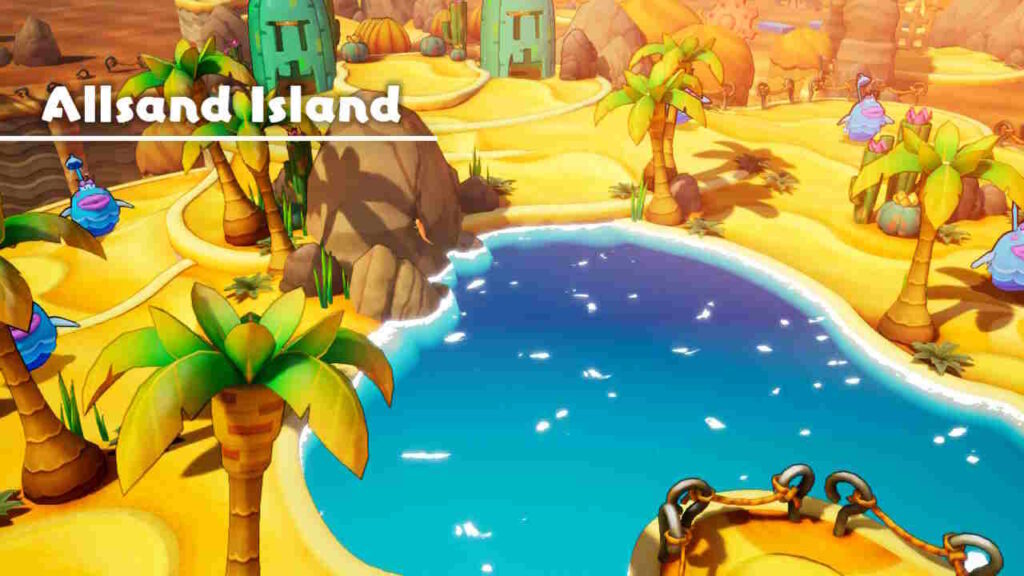
There are plenty of neat places to explore
It’s Mario & Luigi through and through.
Of course, in some sense, that’s probably the understatement of the century. Brothership doesn’t just feel like a Mario & Luigi game…
It feels like a best of collection of mechanics, enemies and concepts from across the series. You’ve got familiar enemies from various games, like Iceads and Sharkbones. Your Bros Attacks are often tweaks on ones from other games, like Bomb Derby, Yoohoo Cannon and Jump Helmet. Overworld abilities are often based on those from said games (like the Bros Ball) and the story takes more than a little inspiration from Dream Team in its formula.

Familiar enemies return, like these Sharkbones from Superstar Saga
It’s all very safe and familiar, and that’s probably for the best in a revival like this one.
What’s more, while the core structure is safe and familiar, that doesn’t necessarily mean the gameplay hasn’t evolved in this new entry. Oh no, in a lot of ways, Mario & Luigi: Brothership feels like an evolution of the former, the next obvious step in how the overworld and battle systems can be expanded upon with this formula.
For example, your overworld abilities are similar to past games, but they’re also fleshed out with new functionality as you make progress in the game too. Being able to spin across gaps may have been done in every game, but being able to suck up or carry objects with a UFO tractor beam? That’s certainly an unexpected addition, and one that adds a lot to the ability later on.
And the same goes with all the others too. The Bros Ball can now brake, charge quickly and ride over rails, the Fire and Ice Flower ability can now combine the powers into a charged explosion, and many of your abilities can be used for creative first strikes in battle too.
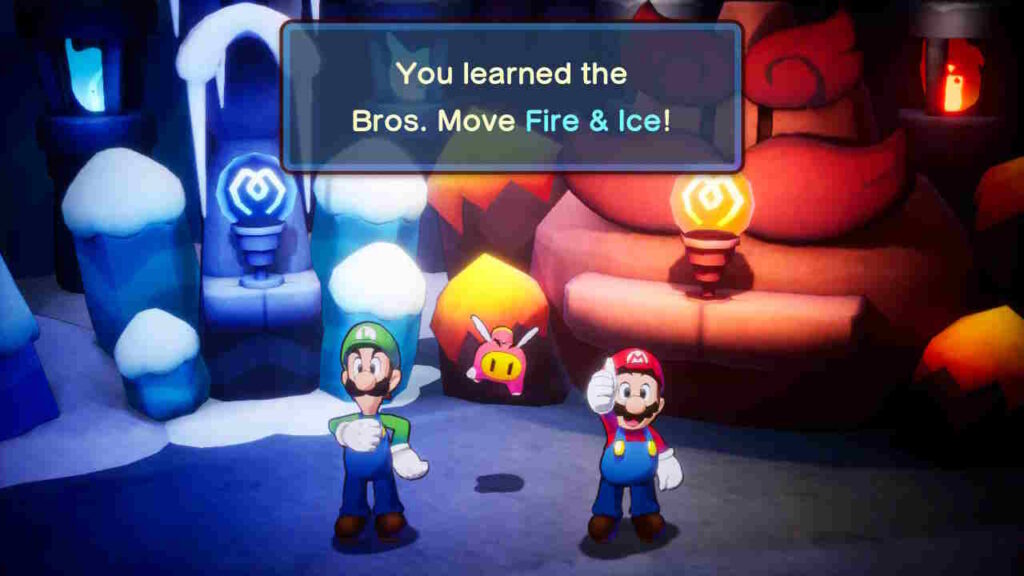
The Fire and Ice Flower abilities are some of the best additions in Brothership
It’s a nice next step in the formula, and means that having just four ‘major’ abilities isn’t seen as a downgrade.
Meanwhile the battles go all out in their complexity. Bros Attacks are now significantly longer and more complex, with the likes of Mix-Max Vortex and Conductor Connector being some of the most insane attacks in the entire series, and boss battles… well, those are another thing entirely.
Since this game adds something called Luigi Logic. When this happens, Luigi will think of a solution to an overworld puzzle or battle challenge, and come up with a creative way to solve it.
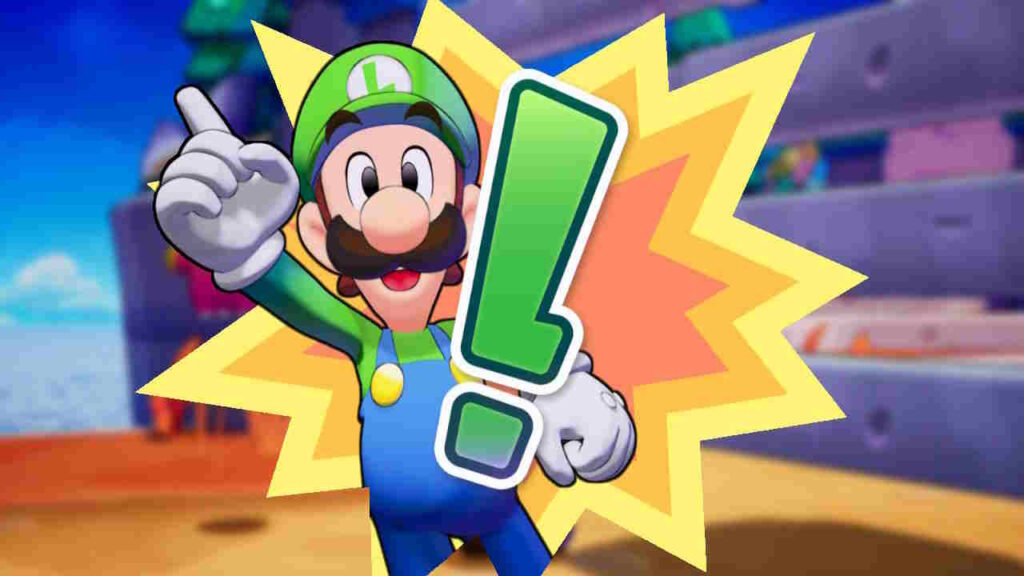
Luigi Logic is a great addition to the game
And it’s the latter where things get truly interesting. You see, while the first two bosses can be fought entirely normally, with Luigi Logic only letting you stun them for a turn or two…
Certain later battles take the mechanic and roll with it. For example, a barrel boss called Spikecask will turn invincible at one point, restoring health while lying sideways.
So, what do you do? Do you out-damage its healing process? Find another setup that could work here?
Hell no! You have Luigi run into the background and play with levers, starting a mini game where you have to stack blocks on top of the boss while avoiding bombs. Then, once enough have fallen, the boss gets stunned, falls off the side of the conveyor belt and crashes down a slope to another arena, taking extra damage all the while. It’s a super creative setup, and one which takes an otherwise ‘okay’ boss and turns it into one of the game’s most memorable moments.
What’s more, the insanity only goes up from there. Stuck dealing with Pipegunk, a boss which gains an elemental form whenever the arena is rotated a certain way?
Have Luigi jump into the background, fight with a member of the Extension Corps for the remote, and then use it to switch the arena into the form that Pipegunk is weak to, stunning for a turn in the process.
The game is full of these setups, where Luigi Logic challenges can start anything from a pipe matching mini game to a shoot up em mid boss fight, and make the battles into something of a spectacle in the process.
Of course, that’s assuming the fights aren’t already spectacles to begin with. And yeah, they already are.
You’ve got bosses with multiple phases, all of which change the arena you’re fighting in. Bosses that shift the camera around 360 degrees for their attacks, meaning your counter attack could be done in almost any perspective imaginable…
Plus, in a few cases, bosses with the ability to either throw one character out of the arena, or even turn them to their side on a temporary basis. It’s all good stuff, and makes major boss encounters a genuine highlight overall.
And the plug system is a nifty addition too. This is basically Brothership’s equivalent of badges or battle cards, and works much the same way. You’ve got a collection of options you unlock throughout the game (by building them with glowing sparks found throughout the world), and you mix or match their effects to change up battles. Some let you attack more times, some give you extra power against certain enemy types, some make you resistant to Glohm or fire attacks, that sort of thing.
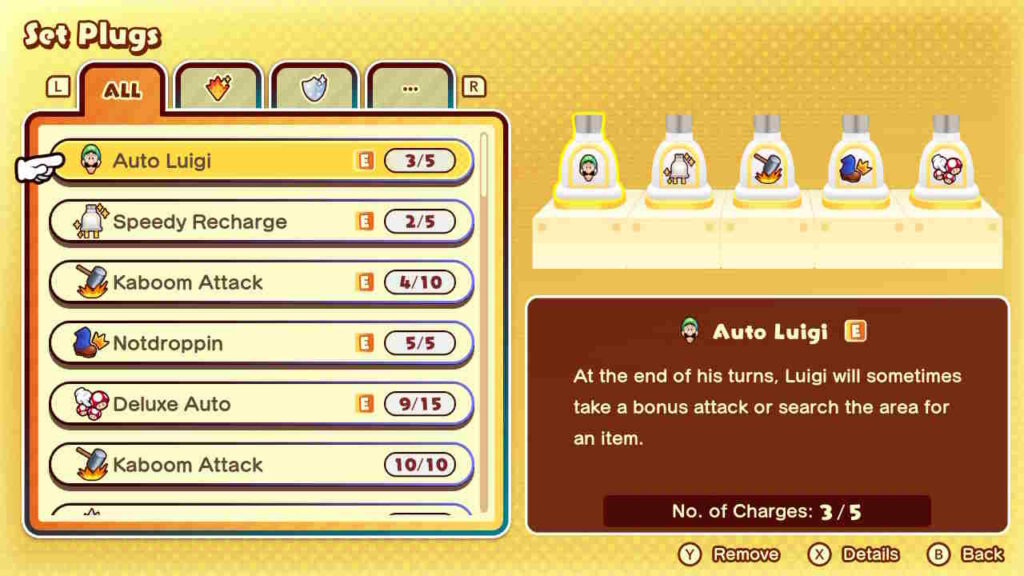
Battle Plugs allow for lots of interesting strategies
It’s fun to mess around, and something that definitely adds a nice layer of strategy to the combat for those willing to look into it.
There are some differences which are more like sidegrades than upgrades though. Like how Luigi’s menus work here.
Since unlike the previous titles, you don’t press B to select his actions anymore. Instead, you confirm with A as usual, and use the B button to cancel like in most games. It’s not a huge deal, and you’ll get used to it soon enough, but it can definitely throw off longtime fans nonetheless. Perhaps a control setting wouldn’t have gone amiss here?
And then there’s Luigi’s AI in general. Put simply, he’s not quite as strongly tethered to Mario as in prior games.
Hence instead of needing to make him jump with B, he tends to jump automatically when following Mario. He can also be seperated from his brother to activate switches or puzzles with the L button, and in some cases will be sent off to do something else so the duo can do two things at once (like distract NPCs, or collect multiple sets of coins).
It’s generally an improvement to the old system (and one which allows a more possibilities than having to find a gate or other obstacle to separate them), but it can be a tad annoying on occasions nonetheless, since Luigi will call Mario back if he can’t reach the latter.
Still, gameplay wise it’s generally solid here, with the battle mechanics being a highlight of the experience and the new mechanics mostly improving on what worked in previous entries. What about the storyline?
Well, the game’s sadly a bit of a mixed bag on that front.
Since on the one hand, the story does get more and more interesting as you get further in the game. There’s a great villain or four, the interplay between Bowser’s troops and said new villain is excellent, and the game goes in some incredible directions in the endgame, with twists that we’d never have expected in a million years.
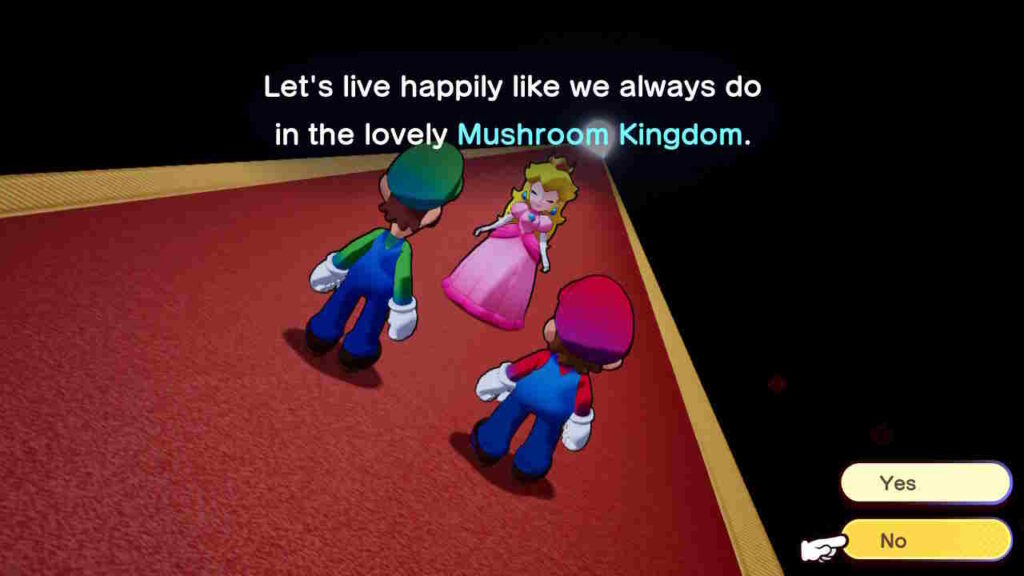
This scene seems rather ominous out of context… and it’s even creepier with said context
With some of these twists involving storyline elements so dark and morbid they’d fit right into Super Paper Mario or Mario & Luigi: Partners in Time.
It’s impressive really, and with everything from omnicidal maniacs to lotus eater machines, hate plagues and apocalypses, this game has it all!
Unfortunately, there’s a fair chance many people won’t actually get to experience this stuff, since the process of getting to that point isn’t always ideal.
Since while the last three or four seas are excellent fun, the first one is… underwhelming to say the least.
Okay, the characters are charming enough, and the islands are at least varied in their theming…
But you’re just so limited in the first three or so hours it’s just ridiculous. You don’t get hammers until after two or three islands, you don’t get Bros Attacks until later than that, and you don’t get things like battle plugs until the second sea entirely.
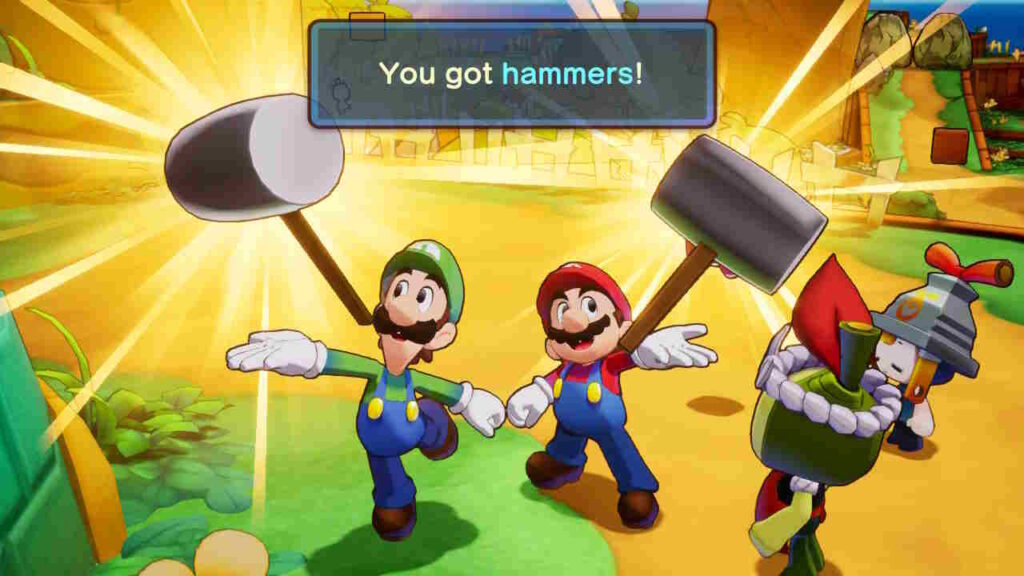
You get these surprisingly late in the game
So the intro area just feels slow as hell. You’re fighting basic enemies with basic attacks, solving puzzles that are so easy and mindless that a 3 year old could probably figure them out, and you have no idea what the plot is beyond “Mario and Luigi are now in this Concordia place, and need to put islands back together again”.
It’s not a great start to the adventure to say the least, and with the villains not even showing up til the first lighthouse, one that feels completely inconsequential in many ways.
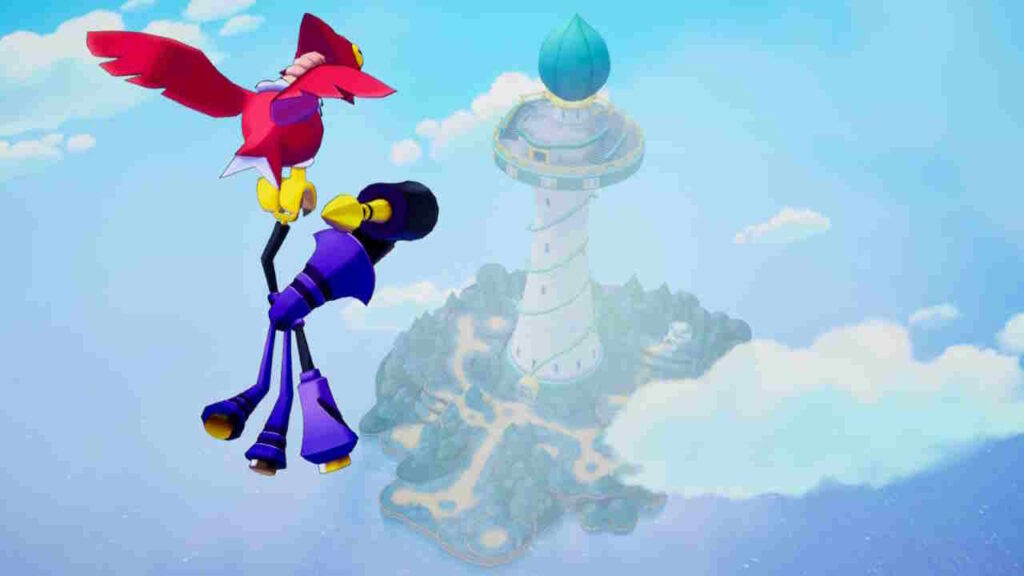
Get used to only minor villain cameos prior to the first Great Lighthouse…
And that plays into another issue that Brothership sometimes runs into in general too. One that’s arguably plagued the series since the very beginning.
The game sometimes feel longer and more drawn out than it probably needs to be.
With lots of areas being padded out to somewhat ridiculous degrees. For example, there’s a dancing mini game on Twistree Island, which is pretty fun the first time around. It fits the character hosting it, makes sense in the story, and mostly acts as a harmless conclusion to the area in general.
How many more times do you think this mechanic will come up? 0? 1?
No, 5.
There are 5 mandatory dance mini games, three of which are in a row in the endgame.
Similarly, the second lighthouse also has an interesting stealth section where you avoid being spotted bt guards by having Luigi hide in a barrel. Fair enough, this setup was done in Paper Jam, and it’s a nice change of pace here.
But again, it keeps coming up in more and more contrived ways. Oh, you got to the third lighthouse? Enjoy being put in prison now, since there’s another mandatory stealth section there! And once you escape, yet another one to get one of the plugs needed to progress in the area.
Then you get to an island later on, and what do you know? You get thrown in prison, and have to clear yet another stealth section to escape.
None of these areas really build on the mechanics in interesting ways, they’re just here because “Mario and Luigi get arrested” acts as a nice pretense for adding an extra 30 or so minutes to the runtime.
There are tons of little elements like this. Sections which fun once or twice, but which get brought out over and over again to fill out runtime, even if they don’t really add anything to the experience.
It’s like the developers had a ‘rule of three’ in their head, an idea that every concept must be explored at least three times in order to avoid wasting it.
And it’s very apparent with the islands themselves. Without exception, you’ll have to visit all of them at least twice, if not three or four times. There’s often no reason for the latter (it could be as minor as a cutscene, or as insane as ‘someone severed the connection, setup the lighthouse again’), but you’ll need to return there nonetheless. Can’t waste those expensive assets, can we?

Get used to this place, you’ll be revisiting it a lot
It also doesn’t help that the sailing is rather slow too. Okay, you can speed it up after a certain point, and you do get the ability to teleport later on…
Yet it’s many hours before either of those things, meaning you’ll have to watch the boat slowly plod along the currents to your next destination without much happening in the background. It’s a fun visual, and it definitely lets them add some cool cameos with the reefs and things…
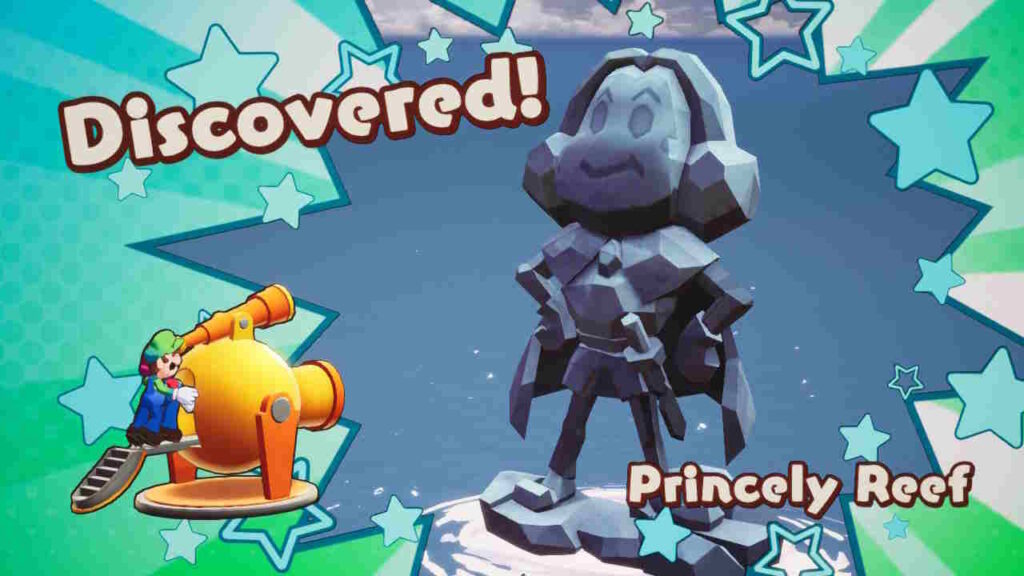
The reefs based on other games are a neat addition
But it’s not ideal here. Your quest to any new sea involves a lot less exploration, and a lot more waiting for a boat to go around a current on the map so the island can actually come into view.
What’s more, it seems to be designed to make undoing mistakes here as annoying as possible too. You see, leaving an island and returning to Shipshape doesn’t put you back by the cannon.
No, it puts you back by the shops instead. So, if that islet you thought was interesting had nothing of value on it and you want to visit somewhere else, you’ll have to waste time slowly walking back to the cannon just to try again. At which point, the place you may have wanted to visit may have passed by in the meantime, and your only bet is to wait for the ship to make another lap of the current to try again.
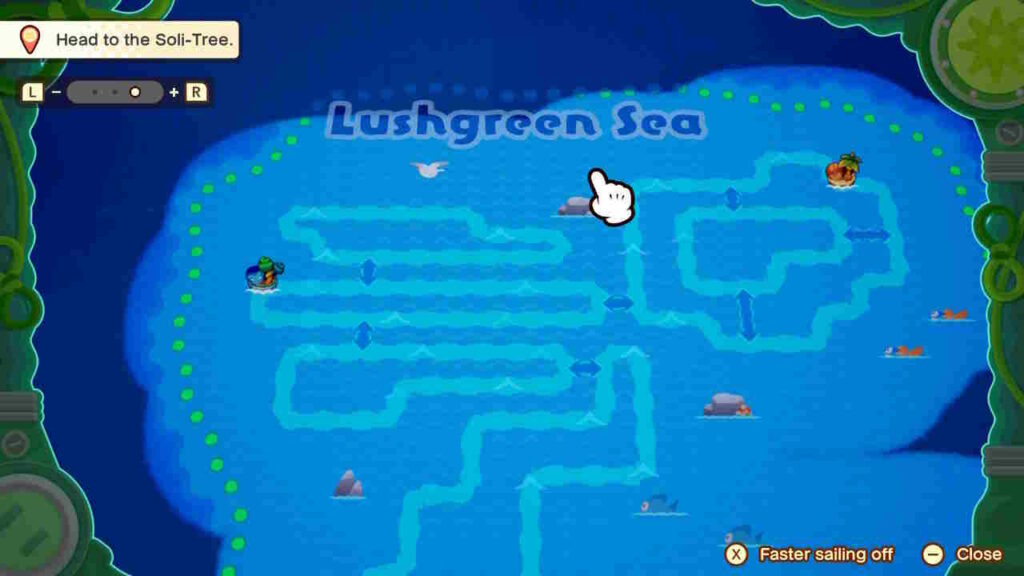
As you can see, the unimportant islets are far apart too…
It’s a slow setup, and one that made us hesitant to do much on the islets at all. Why spend all that time blasting off to a random rock with three blocks on it when the trek back to the cannon will take about as long as the exploration itself?
There’s just no point in it. May as well stick with the major islands and areas, and call it a day, at least when doing otherwise isn’t absolutely necessary.
We’re also not a fan of the railroading here either. You see, while Mario & Luigi games often have at least some railroading in the form of plot tunnels, like being stuck on Dreamy Mount Pajamaja in Dream Team…
Brothership often takes it to somewhat extreme lengths. You’ll get certain quests or character interaction, and you’ll be forced to take them on there and then, no matter what.
And it gets utterly insulting in a few cases. For example, at one point, you’ll encounter a few new characters that will judge your character level and gear to make sure they’re appropriate for that point in the game. That’s a cool feature right? A nice optional way to tell if you’re prepared, and that’s it.
Well, that’s how it is for 99.99% of the game anyway. But the first time they’re introduced, you have to talk to these guys no matter what. You literally can’t leave Shipshape until you do.
So the game’s solution to make sure you know how an optional mechanic works is literally to force you to use it at gunpoint and remove even the ability to do sidequests in the meantime.
But this isn’t the only time this happens. Oh no, the game loves doing this at seemingly random points in the adventure. For example, you have to infiltrate a skyscraper on Lottacoins Island at one point, with the goal being to rescue whoever you sent there to spy on the villains.
That’s cool. It’s a great section of the game with a fun boss battle and a really creative atmosphere.
What’s less cool though is how the game handles a certain story sequence in the building. You rescue the captives, they go down to the lobby to discuss the next part of the quest…
And you have to follow them right there and then. No, it’s not automatic. You’re not dragged there in a cutscene like so many other parts of the game.
You’re made to get there yourself. Without even the option to go back into the room you came from to look for extra collectibles or anything. The game decided you were needed in the lobby, and that’s where you needed to be goddamnit. Continue your mission right now soldier!
It’s rather irritating, and leads into a real consistency issue in the cutscenes and quests too. Put simply, you have no idea how much freedom you’ll get to tackle the next objective until you’re told to do it.
Sometimes it’s just a casual suggestion, and the game will let you go anywhere and everywhere without any issues, sometimes you’ll be made to go somewhere, but given no choice to go anywhere else cause of a metaphorical gun to the back of your head, and sometimes it’ll just fade out or play a cutscene and leave you at your destination.
It’s all rather weird and inconsistent, and causes all manner of random pacing problems in the process.
And that’s probably the big reason for this game’s strange pacing; it’s all very inconsistent in how quality of features and quest progression are handled. Sometimes you can skip cutscenes, sometimes you can fast forward them. Sometimes you can make mini games or quests easier if you fail, sometimes you can’t. There are a lot of small things that feel like they needed an extra do over for quality of life improvements here.
It reminds us a lot of Echoes of Wisdom in that sense. Another game that handled these things in a very inconsistent way, and forgot basic quality of life features for elements that should have been immediately obvious.
Still, padding and slow start aside, there’s still plenty of quality content and replay value on offer in Mario & Luigi: Brothership. You’ve got a nice meaty 40 odd hour story to play through, with tons of unique islands and locales. There are dozens of side quests available throughout the game, including some that are limited by story progression…
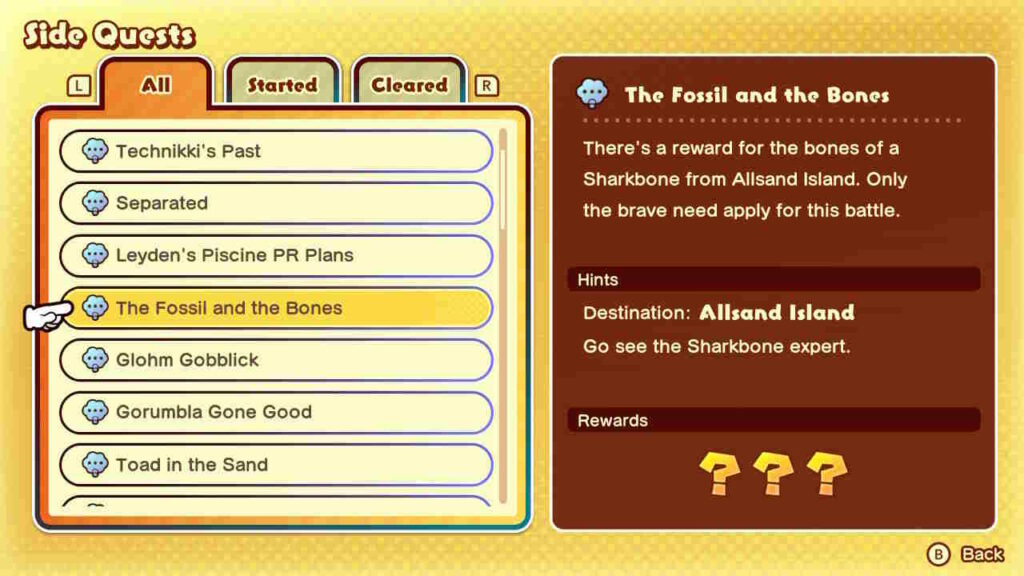
The game has a ton of sidequests to complete
Plus, there’s even some extra replay value in story/world altering choices you’ll make through your adventure.
Yeah, this game actually goes there. Instead of every playthrough being the same, there are numerous points where choosing to do one thing or the other will affect the story and characters in various ways, opening up new side quests and getting you extra content in the process.
Like how you get your hammers early on. There, you have to rescue Willma’s kids from Twistree Island and Raynforst Island, and the first one will become a major character for the rest of the game. They’ll set up shop on Shipshape Island, sell accessories the other won’t provide, offer side quests that are a bit different from the siblings’ ones, etc.
So there’s a definite incentive to replay here, just to see what the other option could have brought to the table.
And there are lots of other examples like that in the game too. You can send one of two characters to get captured for a bit, choose which of two islands to visit first after a particular story moment, decide which NPC’s plans to go with for getting wedding supplies, etc.

How you get these gifts changes a few hours of the game
There aren’t any ‘wrong’ options of course (you’ll always get hammers and an accessory shop, you’ll visit each island eventually, the wedding will go the same way with only minor cosmetic differences, etc)…
But the options are nice to have nonetheless, and add a bit of extra replay value for those wanting to try the game again.
There’s also quite a bit of challenge here, even for longtime Mario & Luigi fans.
Okay, the intro isn’t exactly going to be causing any head scratching any time soon, and the early battles are definitely on the simpler side because of your limited options…
But when the game stops pulling its punches, it really stops pulling its punches. By the second sea you’re dealing with enemies that can move fast, hit hard and have a variety of trick attacks to dodge or counter, as well as bosses where actual puzzle solving and strategy is necessary to make progress at all.
Add this to some tricky overworld exploration, some insane optional enemies and bosses (level 100 Bob-ombs with max stats, Sharkbones that can one shot you at level 60 or so, Lighthouse boss rematches that make the X bosses from the 3DS games look like a joke by comparison), and well, Brothership is certainly the most challenging title in the series so far.
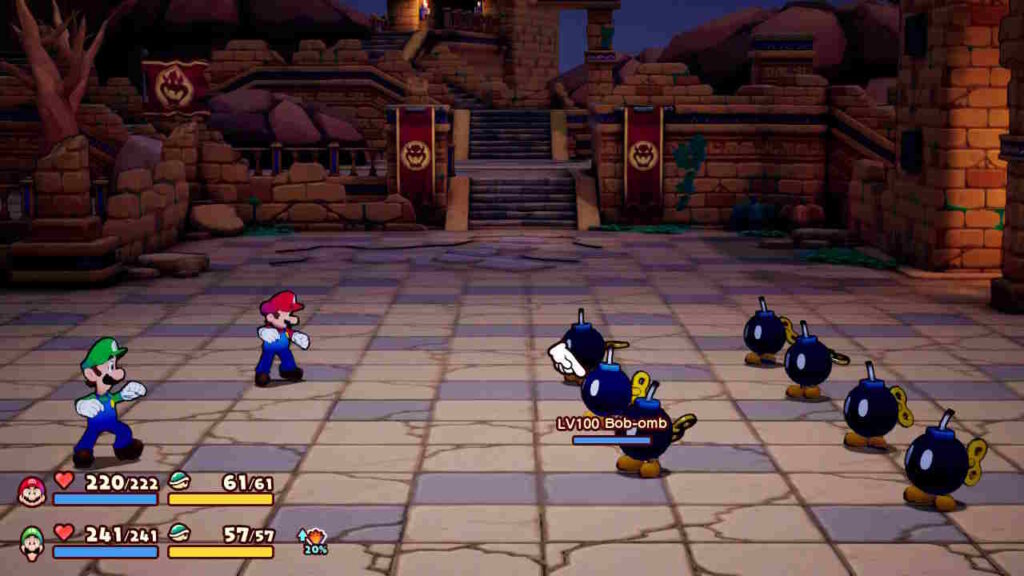
These guys are goddamn horrifying, especially when you try the battle for the first time…
Especially given that unlike the badges in past games, the battle plugs create new strategies to use, not trivialise the game altogether. There are no Danger Mario setups here, no plugs to lower bosses to single digit levels and certainly no time freezing shenanigans, so you’ll have to earn your progress in this game, not just get handed it on a silver platter.
So yeah, Brothership is certainly a step up where difficulty is concerned.
Still, that’s Mario & Luigi: Brothership. It’s a good game overall, and it’ll definitely please fans of the original titles for the most part. With incredible combat, some amazing endgame areas and a story that might be one of the best in the entire series, it’s a definite must buy for anyone that’s a fan of the older Mario & Luigi games, or the Mario RPGs in general.
Just stick with it beyond the first area, okay?